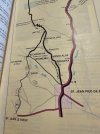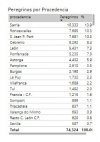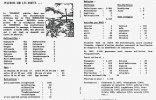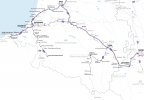By 1990 SJPDP was already the default starting point for most British pilgrims and many others too.
Not at all what I found walking through in 1994 -- most pilgrims in SJPP that time had walked from further away, the great majority from the Le Puy route, though some had come from northern Europe via the Vézelay Way. I was the only one from the Paris/Tours Way.
The minority starting at SJPP were of various nationalities, though the Brits and North Americans were the largest groups. But still, not that many.
The Spanish generally started from Roncesvalles.
Far more people started in 1994 at Roncesvalles than SJPP. Yes the vast majority of those starting there were Spanish, including those busing in for a morning arrival, breakfast, then head out immediately. But in 1994 anyway, people of multiple nationalities started at Roncesvalles, and more than those starting at SJPP. Including Brits.
The Somport route was known but little mentioned.
By 1994 it was more well known and travelled -- it's possible that the Somport route had been revitalised by the 1993 Holy Year. (I wasn't much aware of these things on my own 1993.) It had definitely become a lot more popular by the mid 2000s !!
The pilgrim office detailed statistics go back to 2003. Well before Mr Sheen's movie. In 2003 they recorded 15,376 people who started from SJPDP and Roncesvalles.
Certainly when I walked through SJPP on my 2005, the number of pilgrims starting there had
massively increased compared to the early 90s, by that time dwarfing the number of people starting at Roncesvalles.
I was stunned and shocked by the crowd of them, including because I had met only about a couple dozens of foot pilgrims total on the Way there from home, setting aside the thousands of non-foot pilgrims at Lourdes.
Something happened between the early 1990s and early 2000s, clearly. From the 1970s to the early 90s, the most typical starting point in France was Le Puy ; in the early 2000s, it had become SJPP, and has remained so ever since.
Don't understand what caused this ; things like
The Way only reinforced whatever that was, without causing it originally -- the old 1980s French guide books divided the Way of Saint James into two sections ; Le Puy to Roncesvalles ; Roncesvalles to Santiago (though there was already a separate guidebook for the Arles route). Roncesvalles, not SJPP, was seen as the junction between the Ways in France and Spain.
And only 869 who started from Somport. The numbers from SJPDP and Roncesvalles combined were about 50% larger than those beginning at Sarria in that year - the Camino was still seen mostly as a long-distance pilgrimage. I have to disagree with the idea that "Hardly anyone" started from SJPDP.
It's not true for the early 2000s ; but it is true for the early 1990s and earlier, relative to the numbers starting at Le Puy and Roncesvalles or elsewhere. It was definitely a minority starting point until the late 90s or early 2000s.
As for Sarria, very, very few people started there in the early 1990s, and not even that many in the early 2000s ; though of course, I saw a greater number starting from there on my 2005 than I had seen on the 1994. The importance of Sarria at the time was that it was a small city stop, with shops for supplies, bars and restaurants and whatnot, so that most pilgrims foot and bike stopped there, and so it could get rather crowded. But as the 100K rule for the Compostelas was still pretty new, it was still somewhat unusual to choose it as a starting point -- although some of the pilgrims doing their Caminos in stages did make Sarria to Santiago their final stage.
The final few 100K to Santiago did get progressively more crowded, but this was not principally from people starting there (though some did), but mainly due to the influx from other Camino Ways joining the
Francès at various points.






























